Just back home after an exciting departure from  KOSH this morning along with a lot of other aviators getting out before weather due in later today, nothing like being a part of multiple aircraft departing on the same runway at the same time! If you have any serious interest in aviation, put this annual event on your calendar, you will not be sorry!
KOSH this morning along with a lot of other aviators getting out before weather due in later today, nothing like being a part of multiple aircraft departing on the same runway at the same time! If you have any serious interest in aviation, put this annual event on your calendar, you will not be sorry!
Here are your stories for today...
Be safe out there!
Tom
Crop-dusting helicopter crashes in Lafourche Parish field, pilot dies
The crash occurred around 6:30 a.m. in Lafourche Parish when the aircraft apparently struck a utility line while spraying the field.
Author: Paul Murphy / WWL Louisiana
THIBODAUX, La. — A crop-dusting helicopter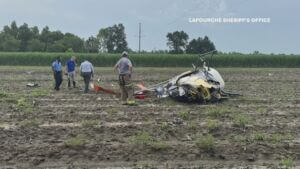 crashed in a sugarcane field in the Laurel Valley area east of Thibodaux on Wednesday morning, killing the pilot.
crashed in a sugarcane field in the Laurel Valley area east of Thibodaux on Wednesday morning, killing the pilot.
The crash occurred around 6:30 a.m. in Lafourche Parish when the aircraft apparently struck a utility line while spraying the field.
"It appears that there was some interaction between the helicopter and a utility line, and it caused the aircraft to crash," Lafourche Parish President Archie Chaisson said.
The pilot was identified as Stanley Hebert Jr. of Abbeville. Sheriff Craig Webre described Hebert as an experienced aviator in his 60s from the Vermillion area.
"He appears to have been flying for quite some time," Webre said.
Chaisson said the crop-duster was spraying a field when the helicopter apparently spun out and crashed.
"We do know there was a single person on board, the pilot, and he is confirmed to be deceased, unfortunately," Chaisson said.
The aircraft belonged to JBI Helicopter Services of Vermillion Parish.
Webre noted that crop-dusting crashes have occurred in the agricultural parish over the years, calling it a profession with little margin for error.
"You're in closed, confined areas," Webre said. "You have to be sensitive to wind direction. You have to be precise where you locate the herbicides, and you have so many various obstacles, everything from trees to power lines to other aircraft, birds, you name it."
The National Transportation Safety Board and Federal Aviation Administration were notified and are leading the investigation into the fatal crash. NTSB and FAA investigators were expected at the crash site Thursday morning.
"We will ask that everyone just join in prayer for his (the pilot's) family and the company itself for the loss," Chaisson said.
https://www.wwltv.com/article/news/local/helicopter-crashes-in-lafourche-parish-sheriff-says-laurel-valley-road/289-eb09b1df-0999-4501-a959-e0a31a26f342
Plane crashes into a building in Helena
By: MTN News
HELENA — A small plane crashed into a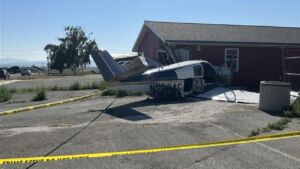 building near the Helena Regional Airport late Wednesday evening.
building near the Helena Regional Airport late Wednesday evening.
The crash happened around 9:50 p.m. on the 3100 block of Bozeman Ave, near the intersection of B Street.
A pilot and passenger were on board at the time of the crash, and both survived the crash, according to Helena Police.
The plane is registered to Peace Sign LLC, based out of Bozeman.
Helena Police, St. Peter's Health EMTs, Airport fire crews, and Helena Fire responded to the incident.
The investigation of the crash will be handled by the FAA.
https://www.ktvh.com/news/a-small-plane-crashed-into-a-building-late-wednesday-in-helena
Plane crashes at Oakland County airport in New Hudson
By Susan Bromley - Hometownlife.com
NEW HUDSON - A small plane crashed at the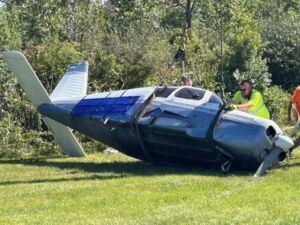 Oakland/Southwest Airport on July 23, severely damaging the plane, but leaving two men uninjured.
Oakland/Southwest Airport on July 23, severely damaging the plane, but leaving two men uninjured.
The men, an instructor and student, were performing "touch and gos" around 11 a.m. in a 1968 Piper Cherokee PA28-140 when the single-engine plane crashed, Oakland County Public Information Officer Bill Mullan said.The men walked away in what Mullan said was "a very fortunate day for them, considering how badly damaged the aircraft was... The aircraft is pretty wrecked."
The plane originated out of Oakland/Southwest Airport, which remains temporarily closed while the fixed wing plane was relocated to a hangar. The Federal Aviation Administration and National Transportation Safety Board were notified and two investigators were on the scene Wednesday afternoon. The last plane crash that Mullan could recall at or near Oakland/Southwest Airport occurred on Jan. 2, 2021, when a plane carrying the Compo family of Northville crashed into a Lyon Township home. David and Michele Compo and their 18-year-old son Dawson died. The family inside the home was spared.
Small aircraft makes crash landing at Leahy Burlington International Airport
Two people were onboard the craft, BTV officials confirmed. There were no injuries.
Michael Cusanelli - Digital Content Manager
SOUTH BURLINGTON, Vt. —
A small aircraft made an emergency landing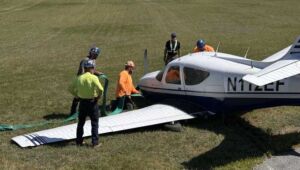 at Leahy Burlington International Airport on Wednesday afternoon, according to airport officials.
at Leahy Burlington International Airport on Wednesday afternoon, according to airport officials.
The 1975 Rockwell International 112 single-engine craft made a hard landing after the pilot ran out of fuel on approach, according to BTV officials.
Viewer video obtained by NBC5 shows the plane appear to be bouncing off the ground before it skids to a stop.
The pilot and one passenger were the only people on board at the time of the crash. No injuries were reported.
Airport officials said the pilot missed the runway, causing the wheels to collapse under the plane. The full extent of the damage to the craft is undetermined at this time.
The crash happened at 1 p.m.
One flight that was already delayed due to a ground stoppage at the destination airport was pushed back an additional several minutes due to the crash, causing that flight to be delayed for a total of 45 minutes, airport officials told NBC5.
The airport is now back up and operating on schedule.
https://www.mynbc5.com/article/aircraft-crash-landing-leahy-burlington-international-airport/65490613
NTSB Final Report: Boeing CH-46E
Pilot Noticed That The No. 2 Engine Torque Indicator Was “Maxed Out” And The No. 1 Torque Indicator Was About 60%
Location: Springerville, Arizona Accident Number: WPR23LA306
Date & Time: August 5, 2023, 15:20 Local Registration: N461WY
Aircraft: Boeing CH-46E Aircraft Damage: Destroyed
Defining Event: Loss of engine power (partial) Injuries: 3 None
Flight Conducted Under: Part 91: General aviation - Firefighting
Analysis: The pilot in command (PIC) reported that the crew had performed firefighting water drop activities for about 2 hours. After they had filled the bucket with water and began to climb, they heard an extremely loud horn in their helmets—loud enough that it was difficult to understand what was being said. The pilot noticed that the No. 2 engine torque indicator was “maxed out” and the No. 1 torque indicator was about 60%.
The pilot released the water in the bucket and initiated a turn to an open field. The pilot then slowly retarded the No. 2 engine control lever out of the FLY position (which took it out of the governing range and into manual mode) to match the torque. He noted that the torque for both engines matched about 90%. Upon turning final for his intended landing field, the pilot noticed that the descent rate increased. The pilot told his copilot to jettison the bucket as he placed the No. 2 engine control lever back into the FLY position. Subsequently, the helicopter landed hard and rolled onto its right side. The engines were shut down and the co-pilot and crew chief assisted the pilot in exiting the helicopter while a postimpact fire ensued.
Postaccident examination of the wreckage showed no evidence of a preimpact engine failure or anomaly that would have precluded normal engine operation. The examination determined that a flex shaft failure did not occur because the cockpit torquemeter displayed Nf values on both engines and each engine’s flex shaft continuity was confirmed. The No. 2 engine signal conditioner, torquemeter relay box, and both torquemeters were destroyed in the post-crash fire and could not be examined.
Helicopter performance calculations for the conditions at the time of the accident show that each engine was only capable of producing a maximum of 85% torque. Neither engine could produce the 100% torque required to trigger the aural overtorque tone, nor was capable of producing the 107% or higher torque required to activate the overtorque indicators on the torque meter. Accordingly, a maximum beep failure did not occur, because neither engine could produce the torque required to trigger the overtorque alarms.
When the PIC heard the overtorque alarm and saw a split in the torque needles, he diagnosed the problem as a “high side failure,” meaning that the engine was producing uncommanded maximum/topping power. However, neither pilot said that they looked to see if either rotation speed of the power turbine (Nf) needles were at zero; in fact, the PIC saw that both Nf needles were reading accurate power turbine speeds. After the PIC retarded the No. 2 engine, the overtorque tone did not go away once the engines were indicating less than 100% torque.
Because the pilot’s torquemeter (which records overtorque events generated by the No 2 engine signal conditioner) indicated 143% overtorque, and all 3 overtorque indicators were red, the No. 2 engine signal conditioner likely malfunctioned and provided false torque readings and overtorque warnings.
Once the PIC took the No. 2 engine out of its governing range, the No. 2 engine was at minimum power, and performance calculations show that the helicopter was not single-engine capable in level flight or hover. The PIC subsequently made a steep landing approach that required more power than was available with one engine. Realizing the need for additional power, the PIC moved the No. 2 engine rapidly to the FLY position; however, that rapid movement likely activated the fail-freeze circuitry, freezing the engine at the minimum power position and switching it to manual mode. Without additional power from the No. 2 engine, the landing approach descent rate could not be arrested and resulted in a hard landing.
Probable Cause and Findings: The National Transportation Safety Board determines the probable cause(s) of this accident to be -- The flight crew’s misidentification of a No. 2 torque sensing system signal conditioner malfunction when both engines were performing normally, which resulted in their attempt to execute a single-engine steep approach and landing without sufficient engine power. Contributing to the accident was the failure of the torque sensing system signal conditioner.
FMI: www.ntsb.gov
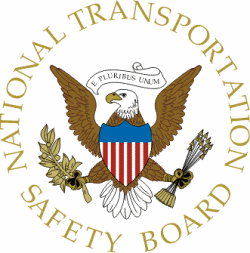
Today in History
11 Years ago today: On 24 July 2014 Air Algérie flight 5017, a McDonnell Douglas MD-83 operated by Swiftair, was destroyed when it crashed following an in flight loss of control 80 km northwest of Gossi, Mali. All 116 occupants sustained fatal injuries.
| Date: | Thursday 24 July 2014 |
| Time: | 01:47 |
| Type: | McDonnell Douglas DC-9-83 (MD-83) |
| Owner/operator: | Air Algérie, lsf Swiftair |
| Registration: | EC-LTV |
| MSN: | 53190/2148 |
| Year of manufacture: | 1996 |
| Total airframe hrs: | 38362 hours |
| Cycles: | 32390 flights |
| Engine model: | P&W JT8D-219 |
| Fatalities: | Fatalities: 116 / Occupants: 116 |
| Other fatalities: | 0 |
| Aircraft damage: | Destroyed, written off |
| Category: | Accident |
| Location: | 80 km NW of Gossi - Mali |
| Phase: | En route |
| Nature: | Passenger - Scheduled |
| Departure airport: | Ouagadougou Airport (OUA/DFFD) |
| Destination airport: | Algiers-Houari Boumediene Airport (ALG/DAAG) |
| Investigating agency: | CEAIAC |
| Confidence Rating: | Accident investigation report completed and information captured |
Narrative:
Air Algérie flight 5017, a McDonnell Douglas MD-83 operated by Swiftair, was destroyed when it crashed following an in flight loss of control 80 km northwest of Gossi, Mali. All 116 occupants sustained fatal injuries.
The airplane was operated by Spanish airline Swiftair on behalf of Air Algérie as flight AH5017 from Ouagadougou, Burkina Faso to Algiers, Algeria.
Flight 5017 took off from runway 22 at Ouagadougou Airport (OUA) at 01:15 UTC (and local time). Following a right turn after takeoff the aircraft headed to the EPOPO point and started climbing to the planned cruising altitude of FL310.
At an altitude of about 10,500 ft, autopilot 1 was engaged, the autothrottle having been active since takeoff. Nine minutes after takeoff, the crew said that they were passing through FL145 and that they estimated EPEPO point at 01:38.
At 01:28, the airplane was transferred to the Ouagadougou CCR and the crew said that they were turning to the left on heading 356° to avoid an bad weather in the area.
During the climb towards FL310, the crew made three heading alterations to the left (of 28°, of 4° then of 8°), then an alteration to the right of 36° to return to heading 019°, close to the initial heading.
At 01:37, the airplane levelled off at FL310 at Mach 0.740. The autopilot then maintained the altitude and heading, while the speed was controlled by the autothrottle. At the same time, the airplane was transferred to the Niamey CCR. In the two minutes following level-off, the airplane's speed increased.
From 1 h 38 min 34, and for about 30 seconds, the autothrottle was in MACH ATL mode. This mode automatically engaged because the thrust needed to reach the Mach speed selected by the pilots was greater than the EPR limit.
The engines' EPR stabilised around 1.92 and the Mach changed from 0.758 to 0.762. The autothrottle then returned to MACH mode and the airplane continued to accelerate up to Mach 0.775.
At 01:39:36, the airplane's speed started to decrease. About one minute later the autothrottle changed back to MACH ATL while the Mach was 0.752. Following that, the altitude remained stable, pitch and EPR increased progressively, while the engines' N1 remained stable and the speed continued to decrease.
Between 01:41:38 and 01:44:29, the Niamey CCR and flight AH5017 tried to get in contact, but did not manage to do so. Flight RAM543K offered to act as the intermediary. The crew of flight AH5017 said, at 01:44:29, that they were at FL310 on a weather avoidance manoeuvre. The Niamey CCR heard this radio exchange and asked them to call back passing GAO and to transmit estimates for MOKAT point. No answer, nor any other messages from flight AH5017, reached the Niamey CCR.
At 01:44, EPR and N1 fluctuations on both engines appeared for about 45 seconds. Then, for about 25 seconds, the EPR decreased then increased again on two occasions from 1.6 to about 2.5. The N1s varied between 70% and 91%. Some roll oscillations between 4° to the left and to the right appeared. The autothrottle disengaged between 01:45:02 and 01:45:06. This disengagement occurred between the first and second EPR variations.
At 01:45:06, the calibrated airspeed was 203 kt, the Mach 0.561 and the airplane started to descend. Pitch increased until it reached 10° at 01:45:17, then decreased slightly while the deflection of the elevators and the position of the trimmable horizontal stabiliser continued pitching up. The EPR and the engines' RPM started to decrease towards values corresponding to idle. The roll oscillations continued and the speed continued to decrease.
At 01:45:35, the autopilot disengaged. The altitude decreased by about 1,150 ft in relation to the flight level, the calibrated airspeed was 162 kt, the Mach 0.439 and both engines were almost at idle. The airplane's pitch began to decrease and the bank was increasing to the left.
The airplane's pitch and bank were then subject to significant changes. They reached, respectively, 80° nose-down and 140° bank to the left. The airplane was pitched nose-down and banked to the left until it struck the ground. The heading decreased continuously and the flight control surfaces remained mainly deflected pitch-up and in the direction of a bank to the right. Around twenty seconds before the impact, the engine speed and EPR increased again and reached values close to maximum thrust.
Analysis of the recorded parameters by the flight data recorder, indicates that about two minutes after the leveling off at FL310, the engine pressure ratio (EPR) value became become incoherent in relation to other engine parameters. This anomaly occurred on the right engine and about 55 seconds later on the left engine. These false readings were probably caused by an obstruction of the pressure sensors located on the nose cone of the engine, presumably by icing. This icing may have been caused by the presence of cold, moist air on the edge of the storm cell, considering the fact that none of the anti-icing systems were activated.
Due to the incorrect values, the auto-throttle tried to maintain a lower thrust than was necessary. The aircraft lost speed and developed a tendency to descend. The autopilot, engaged in altitude hold mode, then attempted to raise the nose in order to maintain altitude. The aircraft ultimately stalled.
The aeroplane speed, piloted by the autothrottle, decreased due to the obstruction of the pressure sensors located on the engine nose cones, probably caused by ice crystals. The autopilot then gradually increased the angle of attack to maintain altitude until the aeroplane stalled. The stall was not recovered. The aeroplane retained a pitch-down attitude and left bank angle down to the ground, while the control surfaces remained mainly deflected pitch up and in the direction of a bank to the right. The aeroplane hit the ground at high speed.
The accident was the result of a combination of the following events:
- the non-activation of the engine anti-icing systems
- the obstruction of the Pt2 pressure sensors, probably by ice crystals, generating erroneous EPR values that caused the autothrottle to limit the thrust produced by the engines to a level below that required to maintain the aeroplane at FL310.
- the crew's late reaction to the decrease in speed and to the erroneous EPR values, possibly linked to the work load associated with avoiding the convective zone and communication difficulties with air traffic control.
- the crew's lack of reaction to the appearance of buffet, the stickshaker and the stall warning.
- the lack of appropriate inputs on the flight controls to recover from a stall situation.
These events could be explained by a combination of the following factors:
- The FCOM procedure relating to the activation of the anti-icing systems that was not adapted to Pt2 pressure sensor obstruction by ice crystals
- Insufficient information for operators on the consequences of a blockage of the Pt2 pressure sensor by icing
- The stickshaker and the stall warning triggering logic that led these devices to be triggered belatedly in relation to the aeroplane stall in cruise;
- the autopilot logic that enables it to continue to give pitch-up commands beyond the stall angle, thereby aggravating the stall situation and increasing the crew's difficulties in recovery.
The absence of a usable CVR recording limited the possibility of analysing the crews behaviour during the flight.
Specifically, it was not possible to study CRM aspects or to evaluate the possible contribution of the employment context and the experience of the crew members.

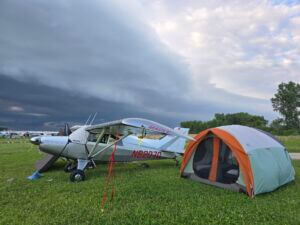 KOSH this morning along with a lot of other aviators getting out before weather due in later today, nothing like being a part of multiple aircraft departing on the same runway at the same time! If you have any serious interest in aviation, put this annual event on your calendar, you will not be sorry!
KOSH this morning along with a lot of other aviators getting out before weather due in later today, nothing like being a part of multiple aircraft departing on the same runway at the same time! If you have any serious interest in aviation, put this annual event on your calendar, you will not be sorry!